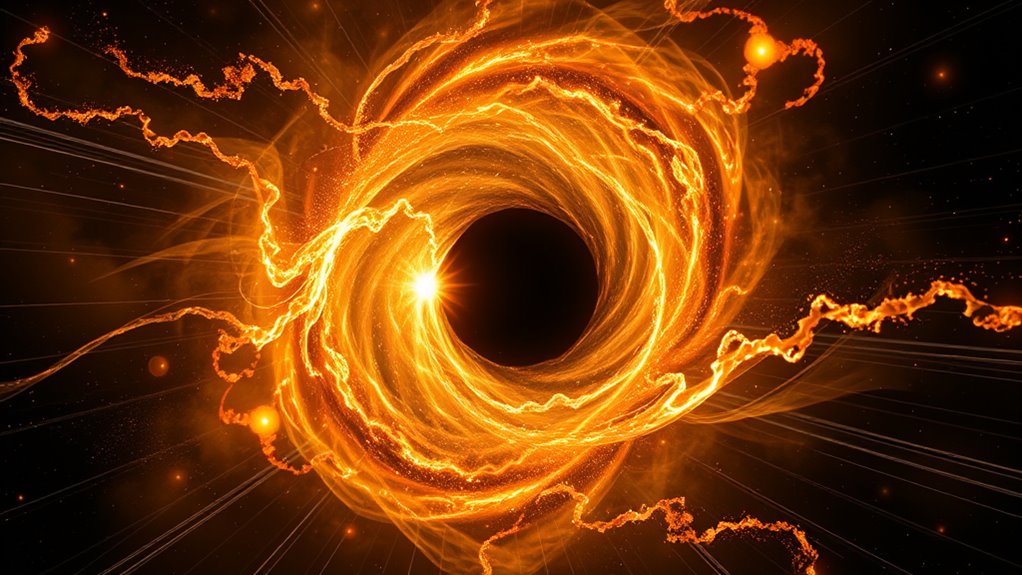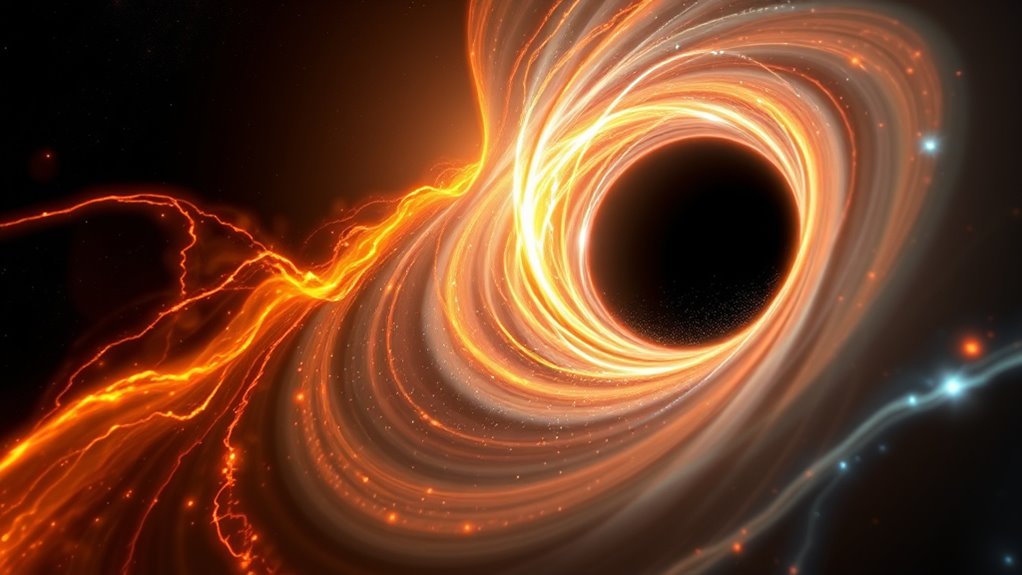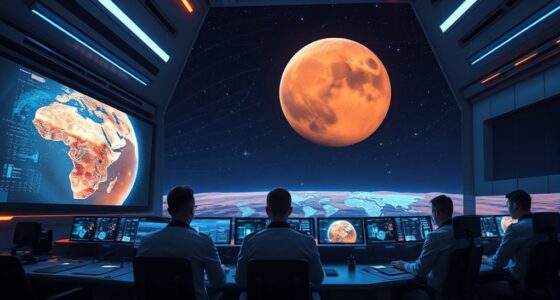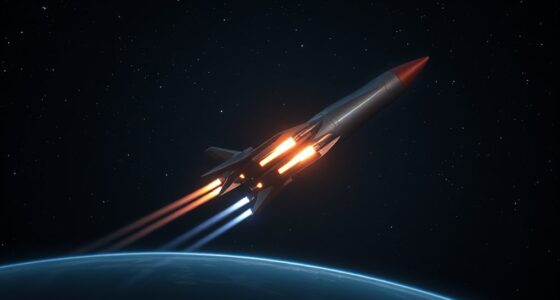Astronomers have captured an extraordinary event where a star is being devoured by a black hole in incredible detail. Using advanced observatories, they’ve observed gravitational waves confirming Einstein’s theory and revealing the star’s final moments, including the formation of an accretion disk emitting X-rays. This event sheds light on black hole growth and stellar evolution. To discover how this breakthrough deepens our understanding of the universe, keep exploring this fascinating cosmic phenomenon.
Key Takeaways
- Astronomers observed a star being torn apart and consumed by a black hole, capturing unprecedented detailed data of the event.
- Gravitational waves detected during the event confirmed theoretical models and revealed core dynamics of the stellar disruption.
- The event showed how material from the star formed an accretion disk, emitting X-rays and illustrating black hole feeding processes.
- Observations supported Einstein’s general relativity, validating predictions about gravity’s behavior during such extreme cosmic phenomena.
- This milestone enhances understanding of stellar evolution, black hole growth, and the interplay between gravity and high-energy astrophysics.

Astronomers have captured an extraordinary event: a star being consumed by a black hole. This rare observation offers a direct glimpse into the dramatic final stages of stellar evolution, revealing how massive stars meet their end. When a star ventures too close to a black hole, the intense gravitational pull begins to tear it apart in a process known as tidal disruption. As the star’s material spirals inward, it forms an accretion disk, heating up and emitting powerful X-rays detectable by telescopes. This event not only highlights the destructive power of black holes but also provides vital insights into how they grow by consuming stellar remnants.
What makes this discovery particularly fascinating is the detailed data collected about the event. Using advanced observatories, scientists have detected ripples in spacetime—gravitational waves—that are emitted during the star’s final plunge. These waves act as a cosmic fingerprint, confirming theories about the violent interactions between stars and black holes. Unlike electromagnetic radiation, gravitational waves carry information about the core dynamics of such cataclysmic occurrences, allowing you to understand the process from a different perspective. Their detection marks a new chapter in astrophysics, enabling you to observe phenomena that were once purely theoretical. This breakthrough also demonstrates how gravitational wave detection can reveal events hidden from traditional electromagnetic observations.
This event also sheds light on the lifecycle of stars and how black holes evolve over time. As a star ages, it undergoes stellar evolution, changing in size, composition, and eventually, its fate. In certain scenarios, especially with massive stars, this evolution culminates in a supernova or direct collapse into a black hole. When a star is devoured by a black hole, you’re witnessing the final act of stellar evolution, where gravity wins out over nuclear fusion. The data collected during this event helps scientists understand how black holes grow by accreting matter, influencing their mass and spin. Additionally, this observation contributes to our understanding of AI safety measures in developing models that can analyze such complex phenomena. Furthermore, analyzing such events enhances our understanding of high-energy astrophysics and the extreme environments near black holes.
The observation of this star’s destruction also offers a rare opportunity to test Einstein’s theory of general relativity under extreme conditions. The gravitational waves detected during the event match predictions made decades ago, providing solid evidence that Einstein’s equations hold true even in the universe’s most violent environments. For you, this means gaining a deeper understanding of how gravity operates on cosmic scales, reinforcing the fundamental principles that govern the universe. Furthermore, studying this event enhances our knowledge of the dynamic processes occurring near black holes, broadening our understanding of high-energy astrophysics.
In essence, witnessing a star being swallowed by a black hole in such detail allows you to piece together the complex story of stellar evolution, black hole growth, and gravitational physics. It confirms that these cosmic phenomena are interconnected, and through them, you get closer to understanding the universe’s most profound mysteries.
Frequently Asked Questions
How Does This Observation Impact Our Understanding of Black Hole Growth?
This observation deepens your understanding of black hole growth by revealing how stellar dynamics influence accretion processes. You see that when stars venture too close, black holes can rapidly consume them, fueling their growth. It highlights the importance of real-time data in studying these events, showing that accretion can happen more dynamically than previously thought. This insight helps you better grasp the complex interactions driving black hole evolution.
Can This Event Help Identify Other Similar Black Hole-Star Interactions?
This event can definitely help you identify other black hole-star interactions by analyzing unique stellar signatures. By studying the details of this event, you can refine your search criteria within event catalogs, making it easier to spot similar occurrences. It provides valuable data that enhances your ability to recognize the telltale signs of such interactions, ultimately expanding your understanding of how black holes grow and influence their surroundings.
What Future Technologies Will Improve Black Hole Observation Accuracy?
Future technologies like advanced space-based telescopes will markedly improve black hole observation accuracy. These telescopes can capture higher-resolution images and gather more detailed data from distant cosmic events. Additionally, AI data analysis will help you process vast amounts of information quickly, identifying subtle signals and patterns. Together, these innovations will deepen your understanding of black holes, enabling you to detect and study their interactions with stars more precisely than ever before.
Are There Any Signs Predicting When a Star Will Be Swallowed?
You can’t precisely predict when a star will be swallowed, but stellar precursors like increased brightness or unusual emissions can hint at tidal disruption events. These signs suggest a star is nearing a black hole’s destructive pull. By monitoring such precursors, astronomers can anticipate an impending tidal disruption, giving them a window to observe the process in detail before the star is fully consumed.
How Does This Event Influence Theories About Galaxy Evolution?
This event acts like a ripple in the pond, shedding light on galaxy evolution. You see, it suggests black holes influence star formation and galaxy mergers more than previously thought. As matter falls in, it can trigger new star birth or disrupt galaxy growth. These insights help refine theories, showing black holes are not just cosmic vacuum cleaners but key players in shaping galaxies over time.
Conclusion
This incredible observation shows that you’re witnessing a cosmic event of a lifetime, opening new doors in understanding black holes. It’s a reminder that the universe has many secrets waiting to be uncovered, and sometimes, you have front-row seats to moments that shake the very foundations of what you thought was possible. As you realize the universe’s vastness, remember: it’s a once-in-a-lifetime opportunity to see something truly extraordinary unfold before your eyes.









